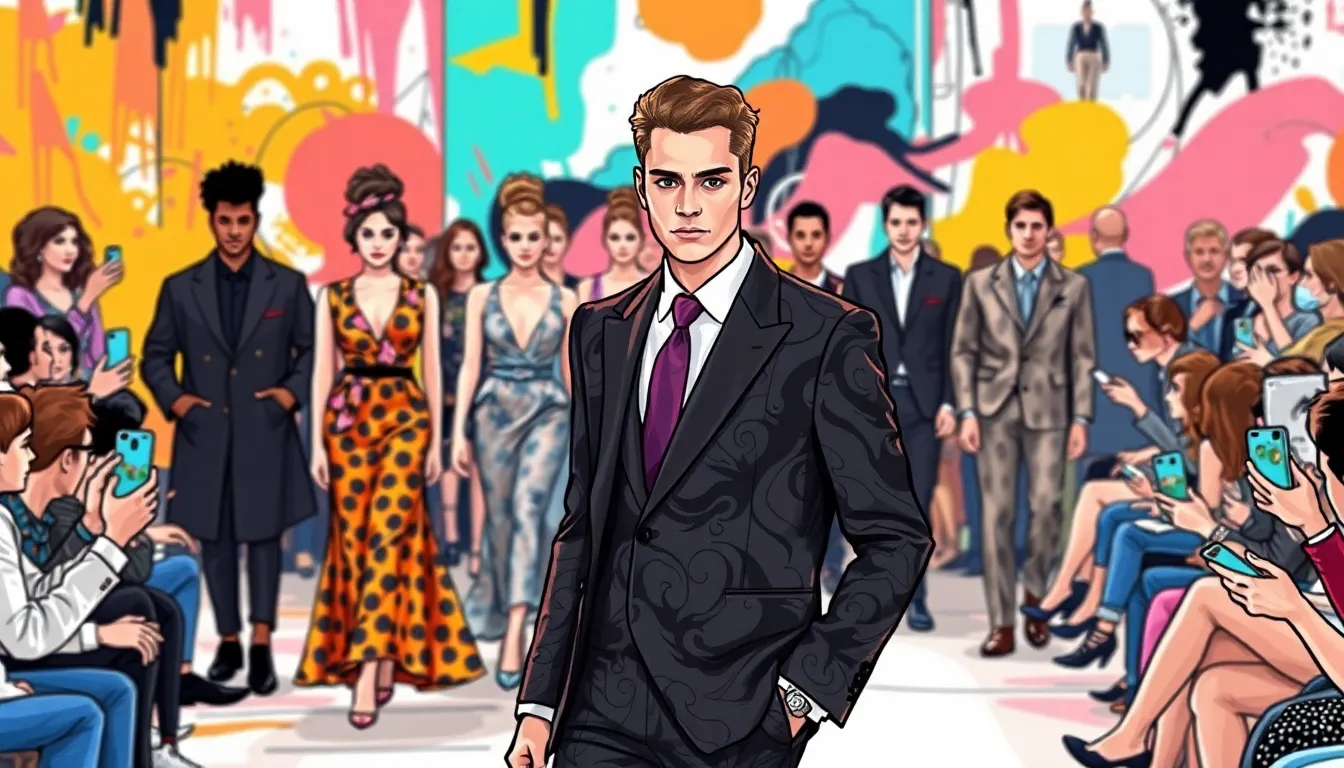In the fast-paced world of fashion, creative direction is the magic wand that transforms mere fabric into jaw-dropping statements. It’s where visionary ideas collide with trends, and suddenly, it’s not just clothing—it’s wearable art. Whether it’s a daring runway show or a quirky ad campaign, the right creative direction can turn heads and spark conversations faster than you can say “couture.”
Table of Contents
ToggleOverview of Creative Direction in Fashion
Creative direction in fashion shapes the visual and conceptual landscape of the industry. This process involves coordinating aspects like color palettes, fabrics, silhouettes, and overall aesthetics to create cohesive collections. Unity in design leads to distinctive brand identities. Each designer’s vision translates into actual products that resonate with consumers.
Fashion shows exemplify the effectiveness of creative direction. Designers showcase their concepts through elaborate runway displays. Often, these presentations incorporate themes that reflect current societal issues, cultural movements, or historical references. Memorable shows can result in heightened public interest and media attention.
Advertising campaigns also rely heavily on creative direction. Strong imagery, strategic storytelling, and innovative concepts help brands convey their messages. Visual narratives create connections that inspire consumer engagement. Brands that excel in their creative approach often see increases in sales.
Furthermore, collaboration plays a pivotal role in effective creative direction. Designers, photographers, stylists, and artists must work together to bring a cohesive vision to life. This synergy drives innovation and pushes creative boundaries. Each team member contributes unique perspectives, enhancing the final product.
Overall, creative direction serves as a guiding force in fashion. It ensures that design concepts remain relevant and impactful in an ever-evolving industry. By prioritizing creativity and collaboration, fashion professionals can connect with their audiences and drive trends forward.
Key Responsibilities of a Creative Director

Creative directors in fashion hold pivotal roles in shaping collections and campaigns. Their contributions directly influence the brand’s success and market position.
Vision and Concept Development
Establishing a unique vision is crucial for a creative director. They develop concepts that reflect current trends while maintaining brand identity. Researching market dynamics and audience preferences informs their strategies. Crafting narratives that resonate engages consumers and enhances brand loyalty. Presenting ideas through mood boards and visual presentations facilitates understanding among stakeholders. Directors ensure that each season introduces innovative elements that excite the audience.
Collaborating with Designers and Teams
Effective collaboration defines the success of a creative director’s role. Working closely with designers, they translate concepts into tangible products. Building strong relationships with photographers and stylists fosters seamless execution of creative ideas. Team meetings encourage brainstorming, allowing diverse perspectives to shape collections. Additionally, mentoring junior team members cultivates talent and nurtures creativity. Encouraging open communication streamlines the design process and improves overall cohesion.
Influences on Creative Direction
Creative direction in fashion is shaped by various influences that reflect the industry’s dynamic nature. Understanding these influences is vital for effective and innovative design.
Cultural and Societal Trends
Cultural movements significantly affect fashion creative direction. Designers often draw inspiration from art, music, and social change, capturing the spirit of the times. For instance, youth culture often drives trends that emphasize individualism and self-expression. Streetwear styles emerge from urban environments, symbolizing grassroots movements. This interaction allows fashion to engage with pressing social issues, like sustainability and diversity. Events such as protests and celebrations deepen the narrative within fashion collections, making them not just visually appealing but also culturally relevant.
Technological Innovations
Technological advancements continuously reshape creative direction in the fashion world. Innovations such as 3D printing and virtual reality offer designers new ways to experiment and present their ideas. These technologies reduce production costs while allowing rapid prototyping. E-commerce platforms also change how consumers engage with brands, making personalized experiences a priority. Social media serves as a vital tool, enabling designers to connect directly with audiences and gather real-time feedback. By utilizing new technologies, creative directors can enhance marketing campaigns and showcase collections more effectively, thus fostering a stronger bond between brands and consumers.
Case Studies in Successful Creative Direction
Successful creative direction manifests through visionary leadership and impactful campaigns, shaping the fashion landscape significantly.
Notable Creative Directors and Their Impact
Visionary creative directors like Karl Lagerfeld and Alessandro Michele redefine brand identities. Lagerfeld’s tenure at Chanel transformed the luxury brand, blending modernity with classic styles. Michele revitalized Gucci, bringing in eclectic aesthetics that resonated with a younger audience. Creative direction by these leaders boosts brand recognition and strengthens market position, aligning collections with consumer desires. Their unique visions often highlight cultural relevance, making fashion more relatable and engaging. Brands flourish under such guidance, ensuring they remain competitive in a dynamic industry.
Analysis of Iconic Fashion Campaigns
Memorable fashion campaigns, such as Burberry’s “Art of the Trench,” showcase the power of creative direction. This campaign involved inviting consumers to share images wearing Burberry trench coats, creating a sense of community. Similarly, the Calvin Klein “#MyCalvins” campaign encouraged consumers to personalize interactions, blending personal expression with branding. Campaigns like these leverage storytelling and visual appeal to connect with audiences effectively. The integration of social media further amplifies their reach, creating buzz and driving consumer engagement. Innovative strategies enhance brand loyalty and encourage repeat business, illustrating the effectiveness of strong creative direction.
Future Trends in Creative Direction
Sustainability stands at the forefront of future trends, driving brands to adopt eco-friendly practices in their creative direction. Many designers prioritize materials that minimize environmental impact, pushing the industry toward ethical production. Inclusion and diversity shape visual narratives more than ever, reflecting broader societal movements and consumer demand for representation.
Technological advancements influence the creative landscape significantly. Virtual reality and augmented reality allow designers to create immersive experiences, enhancing customer interactions with collections. Brands increasingly explore digital storytelling through social media platforms, engaging consumers in real time.
Artificial intelligence aids in trend forecasting, providing insights that shape design decisions. Data analytics influence creative direction by identifying consumer preferences and predicting future needs. Increased reliance on e-commerce requires brands to adapt visuals to appeal to online shoppers, integrating aesthetics that resonate across digital marketplaces.
Collaboration between creative teams and artists becomes crucial as interdisciplinary approaches gain popularity. Fashion houses invite visual artists and musicians into the design process, enriching collections with innovative ideas. This collaboration extends to global influences, where designers draw inspiration from international trends, embracing a multicultural approach.
The role of experiential marketing expands, focusing on creating memorable brand interactions. Fashion shows evolve from mere presentations to immersive events, enhancing audience engagement. Highlighting unique brand stories captivates consumers, fostering loyalty through emotional connections with products.
Emerging designers gain recognition, driving fresh perspectives in creative direction. Their innovative concepts challenge traditional norms, often embracing avant-garde elements that captivate younger audiences. These trends disrupt established practices and propel the fashion industry toward a more dynamic future, with creative direction serving as the catalyst for these transformations.
Creative direction is the heartbeat of the fashion industry. It transforms mere clothing into powerful statements and artistic expressions that resonate with audiences. By harmonizing various elements and drawing inspiration from cultural trends, creative directors craft collections that not only captivate but also foster brand loyalty.
As the industry evolves, the role of creative direction becomes even more critical. Embracing sustainability and diversity while leveraging technology ensures that fashion remains relevant and engaging. The future holds exciting possibilities as emerging designers and innovative marketing strategies continue to reshape the landscape. Ultimately, creative direction will remain essential in guiding fashion toward a vibrant and inclusive future.


